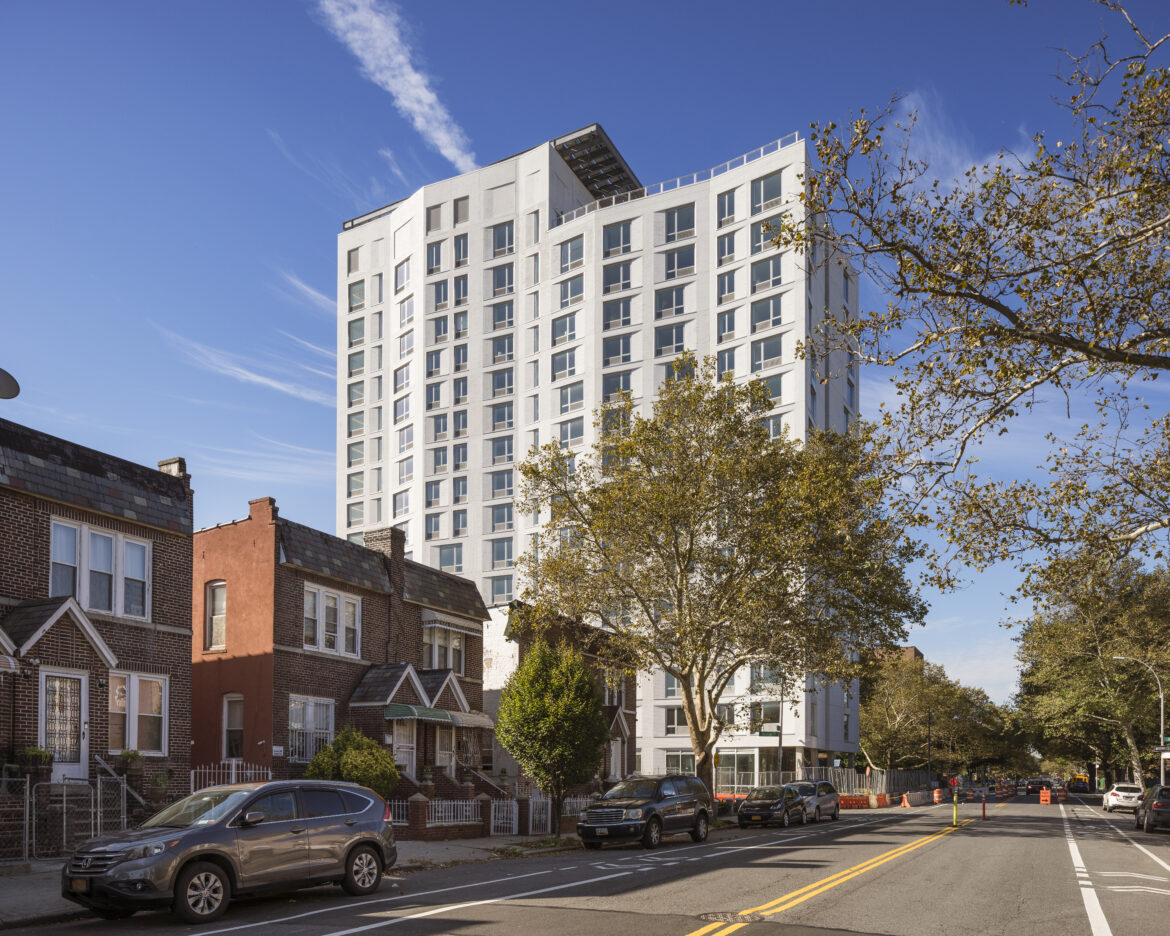“Infills can create new housing while also helping provide funding or upgrades to preserve existing buildings, all helping to reinvigorate a neighborhood.”

NYC HPD
Casa Celina, an affordable housing development built on a NYCHA campus in the Bronx.On NYCHA’s Sotomayor Campuses in the Bronx, a previously underutilized parking lot has transformed into 204 beautiful and deeply affordable apartments for older adults. More than 60 of those apartments will house formerly homeless seniors.
This new development, called Casa Celina, isn’t just a safe, stable home—it will be a thriving community. One with a gym, laundry room, library space, rooftop terrace, community room, 24-hour security, and lounges on every floor, and where JASA, the nonprofit manager of the property, will provide supportive services and community-building events to ensure residents can age with dignity and purpose in their own homes. For hundreds of older New Yorkers, Casa Celina is going to be truly life-changing.
Casa Celina is an example of a campus infill development—in which underused space on church or NYCHA campuses is converted into new affordable housing. Infills can create new housing while also helping provide funding or upgrades to preserve existing buildings, all helping to reinvigorate a neighborhood.
But currently, outdated and arbitrary zoning rules make a lot of infill opportunities impossible to pursue. For example, take a church that has available space and density on its property and wants to use that space to create housing. Even if their proposal adheres to height restrictions, arbitrary zoning regulations—such as the distance of the church from the street or required distance between buildings—could prevent the church from creating the new housing.
Infills provide an incredible opportunity to address our housing crisis and boost communities— but current zoning is making it too hard for other projects like Casa Celina to happen.
That’s where the City of Yes for Housing Opportunity comes in, with a set of common-sense reforms to campus development that will make it a little easier for communities to transform underutilized space—rejuvenating neighborhoods and contributing to the housing supply.
And involving the whole community is crucial. For Casa Celina, that meant not only the local community board and elected officials, but NYCHA residents as well. On NYCHA campuses, potential infill locations are first identified by the public housing agency, after which they select thoughtful development partners for the project. The entire process has been guided by extensive community engagement.
From very early in the process of Casa Celina, our development team—Xenolith Partners LLC, JASA, ELH Mgmt. LLC, and The Kretchmer Companies—engaged with the NYCHA Tenant Association President and worked closely with NYCHA staff. We met with NYCHA residents extensively to hear and work to resolve their concerns, ranging from parking to the impacts of construction, while also keeping residents informed of planning and construction progress.
Casa Celina is really important for the existing NYCHA residents too. As part of the development, 35 percent of units at Casa Celina are set aside for former NYCHA residents and those on the NYCHA waitlist, and the development team also committed to repairing some of the existing parking spaces and improving drainage in the area to alleviate persistent flooding. A portion of the first floor of the building is also a community facility that is designed to bring services to Bronx residents, which will help make supportive services increasingly available to the broader community.
Extensive community engagement is critical in infill projects—and will still be required with City of Yes to ensure the potential new projects benefit the whole community. I’ve seen firsthand the impact that Casa Celina is already having on the Bronx. But unfortunately I also know that for those 204 units, we received 24,000 applications. The demand for affordable housing is unfathomable right now.
Addressing the demand for affordable housing for seniors, in particular, is urgent. The rate of homelessness among older adults has never been higher than today in New York City, and estimates show that we must build 400,000 units of affordable housing specifically for seniors by 2040 to meet our city’s needs.
That means we have to start taking serious action today to make more communities like Casa Celina possible across the city. City of Yes is an important step.
Kathryn Haslanger is the CEO of JASA, a leading nonprofit serving older adults and the largest nonprofit manager of senior affordable housing in NYC.









3 thoughts on “Opinion: City of Yes Will Help Turn Underutilized Space into Life-Saving Housing”
As I pointed out in the op-ed with my Queens Community Board 13 colleagues that appeared on City Limits Monday, no need exists to rezone the entire City to accomplish any affordable housing goal (Please read it at: https://citylimits.flywheelstaging.com/2024/09/16/opinion-nyc-needs-smart-growth-affordability-not-hikes-in-density/.). City just needs to create zoning designations that can be pursued and applied where needed and helpful. Nothing prevents a community-developer (in this case I presume a non-profit developer) collaboration around any compelling community need and benefit.).
The entire point of the City of Yes for Housing Opportunity is because the process you mention has been ineffective.
Community boards are one of the major reasons for our housing crisis.
Casa Celina is an excellent example of infill. The City of Yes for Housing Opportunity should go further and designate all NYCHA developments minimum R6 zoning, which would designate them all “high density campuses.” This would allow for even more housing than the current proposal.